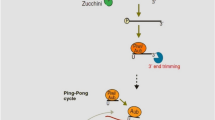Abstract
Introduction
PIWI interacting RNAs (piRNAs) are endogenous regulatory non-coding RNAs which are generally expressed in the germline across animal species. The expressions of piRNAs in tumor tissue were rarely reported until now. The aim of this study was to investigate the expression of piRNAs in breast cancer.
Materials and methods
Deep sequencing was carried out in four tumor and four matched non-tumor tissues from resected breast cancer cases to screen out differentially expressed piRNAs. Furthermore, the result was evaluated by real-time reverse transcription-polymerase chain reaction (RT-PCR) technology in 50 patients with breast cancer and the piRNA expression levels were correlated with clinicopathologic features.
Results
Through deep sequencing, six differentially expressed piRNAs were screened out (5 up- and 1 down-regulated) in the four tumor tissues compared with matched non-tumor tissues. Among them, 4 piRNAs (piR-4987, piR-20365, piR-20485 and piR-20582) were confirmed to be up-regulated by realtime RT-PCR in 50 breast cancer (P < 0.001). Moreover, up-regulated piR-4987 expression was associated with lymph node positivity (P = 0.001).
Conclusions
PiRNAs might play a role in breast cancer and act as tumor markers.


Similar content being viewed by others
References
Voinnet O (2009) Origin, biogenesis, and activity of plant microRNAs. Cell 136:669–687
Carthew RW, Sontheimer EJ (2009) Origins and mechanisms of miRNAs and siRNAs. Cell 136:642–655
Houwing S, Kamminga LM, Berezikov E et al (2007) A role for Piwi and piRNAs in germ cell maintenance and transposon silencing in Zebrafish. Cell 129:69–82
Ghildiyal M, Zamore PD (2009) Small silencing RNAs: an expanding universe. Nat Rev Genet 10:94–108
Moazed D (2009) Small RNAs in transcriptional gene silencing and genome defence. Nature 457:413–420
Visone R, Croce CM (2009) MiRNAs and cancer. Am J Pathol 174:1131–1138
Rosenfeld N, Aharonov R, Meiri E et al (2008) MicroRNAs accurately identify cancer tissue origin. Nat Biotechnol 26:462–469
Wang V, Wu W (2009) MicroRNA-based therapeutics for cancer. BioDrugs 23:15–23
Aravin A, Gaidatzis D, Pfeffer S et al (2006) A novel class of small RNAs bind to MILI protein in mouse testes. Nature 442:203–207
Girard A, Sachidanandam R, Hannon GJ et al (2006) A germline-specific class of small RNAs binds mammalian Piwi proteins. Nature 442:199–202
Grivna ST, Beyret E, Wang Z et al (2006) A novel class of small RNAs in mouse spermatogenic cells. Genes Dev 20:1709–1714
Brennecke J, Aravin AA, Stark A et al (2007) Discrete small RNA-generating loci as master regulators of transposon activity in Drosophila. Cell 128:1089–1103
Lee EJ, Banerjee S, Zhou H et al (2011) Identification of piRNAs in the central nervous system. RNA 17:1090–1099
Yan Z, Hu HY, Jiang X et al (2011) Widespread expression of piRNA-like molecules in somatic tissues. Nucl Acids Res 39:6596–6607
Lu Y, Li C, Zhang K et al (2010) Identification of piRNAs in Hela cells by massive parallel sequencing. BMB Rep 43:635–641
Cheng J, Guo JM, **ao BX et al (2011) piRNA, the new non-coding RNA, is aberrantly expressed in human cancer cells. Clin Chim Acta 412:1621–1625
Cheng J, Deng H, **ao B et al (2012) piR-823, a novel non-coding small RNA, demonstrates in vitro and in vivo tumor suppressive activity in human gastric cancer cells. Cancer Lett 315:12–17
Wolff AC, Hammond ME, Schwartz JN et al (2007) American Society of Clinical Oncology/College of American Pathologists guideline recommendations for human epidermal growth factor receptor 2 testing in breast cancer. J Clin Oncol 25:118–145
Hammond ME, Hayes DF, Dowsett M et al (2010) American Society of Clinical Oncology/College Of American Pathologists guideline recommendations for immunohistochemical testing of estrogen and progesterone receptors in breast cancer. J Clin Oncol 28:2784–2795
Livak KJ, Schmittgen TD (2001) Analysis of relative gene expression data using real-time quantitative PCR and the 2(−delta delta C(T)) method. Methods (San Diego, Calif) 25:402–408
Malone CD, Hannon GJ (2009) Small RNAs as guardians of the genome. Cell 136:656–668
Taft RJ, Pang KC, Mercer TR et al (2010) Non-coding RNAs: regulators of disease. J Pathol 220:126–139
Thomson T, Lin H (2009) The biogenesis and function of PIWI proteins and piRNAs: progress and prospect. Annu Rev Cell Dev Biol 25:355–376
Dharap A, Nakka VP, Vemuganti R (2011) Altered expression of PIWI RNA in the rat brain after transient focal ischemia. Stroke 42:1105–1109
Iskow RC, McCabe MT, Mills RE et al (2010) Natural mutagenesis of human genomes by endogenous retrotransposons. Cell 141:1253–1261
Rouget C, Papin C, Boureux A et al (2010) Maternal mRNA deadenylation and decay by the piRNA pathway in the early Drosophila embryo. Nature 467:1128–1132
Carter CL, Allen C, Henson DE (1989) Relation of tumor size, lymph node status, and survival in 24,740 breast cancer cases. Cancer 63:181–187
Qiao D, Zeeman AM, Deng W et al (2002) Molecular characterization of hiwi, a human member of the piwi gene family whose overexpression is correlated to seminomas. Oncogene 21:3988–3999
Lee JH, Schutte D, Wulf G et al (2006) Stem-cell protein Piwil2 is widely expressed in tumors and inhibits apoptosis through activation of Stat3/Bcl-XL pathway. Hum Mol Genet 15:201–211
Liu X, Sun Y, Guo J et al (2006) Expression of hiwi gene in human gastric cancer was associated with proliferation of cancer cells. Int J Cancer 118:1922–1929
Acknowledgments
This work was supported by Wenzhou Science and Technology Bureau (Grant numbers Y20100008, Y20080081) and Health Bureau of Zhejiang Province (Grant number 2009B106).
Conflict of interest
The authors have declared no conflict of interest.
Author information
Authors and Affiliations
Corresponding author
Rights and permissions
About this article
Cite this article
Huang, G., Hu, H., Xue, X. et al. Altered expression of piRNAs and their relation with clinicopathologic features of breast cancer. Clin Transl Oncol 15, 563–568 (2013). https://doi.org/10.1007/s12094-012-0966-0
Received:
Accepted:
Published:
Issue Date:
DOI: https://doi.org/10.1007/s12094-012-0966-0




